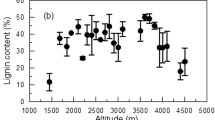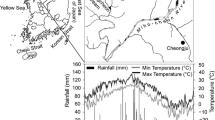Abstract
During microbial breakdown of leaf litter a fraction of the C lost by the litter is not released to the atmosphere as CO2 but remains in the soil as microbial byproducts. The amount of this fraction and the factors influencing its size are not yet clearly known. We performed a laboratory experiment to quantify the flow of C from decaying litter into the soil, by means of stable C isotopes, and tested its dependence on litter chemical properties. Three sets of 13C-depleted leaf litter (Liquidambar styraciflua L., Cercis canadensis L. and Pinus taeda L.) were incubated in the laboratory in jars containing 13C-enriched soil (i.e. formed C4 vegetation). Four jars containing soil only were used as a control. Litter chemical properties were measured using thermogravimetry (Tg) and pyrolysis–gas chromatography/mass spectrometry–combustion interface–isotope ratio mass spectrometry (Py–GC/MS–C–IRMS). The respiration rates and the δ13C of the respired CO2 were measured at regular intervals. After 8 months of incubation, soils incubated with both L. styraciflua and C. canadensis showed a significant change in δ13C (δ13Cfinal = −20.2 ± 0.4‰ and −19.5 ± 0.5‰, respectively) with respect to the initial value (δ13Cinitial = −17.7 ± 0.3‰); the same did not hold for soil incubated with P. taeda (δ13Cfinal:−18.1 ± 0.5‰). The percentages of litter-derived C in soil over the total C loss were not statistically different from one litter species to another. This suggests that there is no dependence of the percentage of C input into the soil (over the total C loss) on litter quality and that the fractional loss of leaf litter C is dependent only on the microbial assimilation efficiency. The percentage of litter-derived C in soil was estimated to be 13 ± 3% of total C loss.




Similar content being viewed by others
References
Anderson JM, Ineson P (1982) A soil microcosm system and its applications to measurements of respiration and nutrient leaching. Soil Biol Biochem 14:415–416
Balesdent J, Mariotti A, Guillet B (1987) Natural 13C abundance as a trace for studies of soil organic matter dynamics. Soil Biol Biochem 19:25–30
Berg B (1986) Nutrient release from litter and humus in coniferous forest soils—a mini review. Scand J For Res 1:359–369
Berg B (2000) Litter decomposition and organic matter turnover in northern forest soils. For Ecol Manage 133:13–22
Berg B, Agren GI (1984) Decomposition of needle litter and its organic chemical components: theory and field experiments. Long-term decomposition in a Scots pine forest. III. Can J Bot 62:2880–2890
Berg B, Ekhbom G (1991) Litter mass loss rates and decomposition patterns in some needles and leaf litter types. Long-term decomposition in a Scots pine forest. VII. Can J Bot 69:1449–1456
Berg B, Staaf H (1980) Decomposition rates and chemical changes in decomposing needle litter of Scots pine. II. Influence of chemical composition. In: Persson T (ed) Structure and function of northern coniferous forests, vol 32. Ecological Bulletins, NFR, pp 373–390
Berg B, Staaf H, Wessen B (1987) Decomposition and nutrient release in needle litter from nitrogen-fertilized Scots pine (Pinus sylvestris) stands. Scand J For Res 2:399–415
Bertolini T, et al. (2005) Optimized sample preparation for isotopic analyses of CO2 in air: systematic study of precision and accuracy dependence on driving variables during CO2 purification process. J Mass Spectrom 40:1104–1108
Bocock KL, Gilbert O (1957) The disappearance of leaf litter under different woodland conditions. Plant Soil 9:179–185
Chapin IFS, Matson PA, Mooney HA (2002) Principles of terrestrial ecosystem ecology. Springer, New York
Corbeels M (2001) Plant litter and decomposition: general concepts and model approaches. NEE Workshop proceedings
Cortez J, Bouche M (2001) Decomposition of mediterranean leaf litters by Nicodrilus meridionalis (Lumbricidae) in laboratory and field experiments. Soil Biol Biochem 33:2023–2035
Cortez J, Demard JM, Bottner P, Jocteur Monrozier L (1996) Decomposition of Mediterranean leaf litters: a microcosm experiment invetigating relationships between decomposition rates and litter quality. Soil Biol Biochem 28:443–452
Cotrufo MF, Ineson P, Rowland P (1994) Decomposition of tree leaf litters grown under elevated CO2: effect of litter quality. Plant Soil 103:121–130
Cotrufo MF, Drake B, Ehleringer JR (2005) Palatability trials on hardwood leaf litter grown under elevated CO2: a stable carbon isotope study. Soil Biol Biochem 37:1105–1112
Del Galdo I, Six J, Peressotti A, Cotrufo MF (2003) Assessing the impact of land-usechange on soil C sequestration in agricultural soils by means of organic matter fractionation and stable C isotopes. Global Change Biol 9:1204–1213
Enriquez S, Duarte CM, Sand-Jensen K (1993) Patterns in decomposition rates among photosynthetic organisms: the importance of detritus C:N:P content. Oecologia 94:457–471
Falconer GJ, Wright JW, Beall HW (1933) The decomposition of certain type of fresh litter under field conditions. Am J Bot 20:196–203
Fernandez I, Cadish G (2003) Discrimination against 13C during degradation of simple and complex substrates by two white rot fungi. Rapid Commun Mass Spectrom 17:2614–2620
Fernandez I, Mahieu N, Cadish G (2003) Carbon isotopic fractionation during decomposition of plant materials of different quality. Global Biogeochem Cycles 3:1075–1086
Fritsche W (1998) Umwelt-Mikrobiologie. Fisher, Jena
Gartner TB, Cardon ZG (2004) Decomposition dynamics in mixed-species leaf litter. Oikos 104:230–246
Gholz HL, Wedin DA, Smitherman SM, Harmon ME, Parton MJ (2000) Long-term dynamics of pine and hardwood litter in contrasting environments: toward a global model of decomposition. Global Change Biol 6:751–765
Gillon D, Joffre R, Ibrahima A (1999) Can litter decomposability be predicted by near infrared reflectance spectroscopy? Ecology 80:175–186
Gleixner G, Schmidt HL (1998) On-line determination of group specific isotope ratios in model compounds and acquatic humic substances by coupling pyrolysis to GC-C-IRMS. In: Stankiewics BA, Van Bergen PF (ed) 214th National Meeting of the American Chemical Society. American Chemical Society, Las Vegas, Nev., pp 34–45
Gleixner G, Bol B, Balesdent J (1999) Molecular insight into soil carbon turnover. Rapid Commun Mass Spectrom 13:1278–1283
Gleixner G, Czimczik CJ, Kramer C, Lühker B, Schmidt WIM (2001) Plant compounds and their turnover and stabilization as soil organic matter. In: Schulze EDHM, Harrison S, Holland E, Lloyd J, Prentice IC, Schimel D (eds) Global biogeocemical cycles in the climate system. Academic Press, Jena, pp 201–215
Harris D, Horwarth WR, Van Kessel C (2001) Acid fumigation of soils to remove carbonates prior to total organic carbon or carbon-13 isotopic analasys. Soil Sci Soc Am J 65:1853–1856
Heal O, Anderson J, Swift M (1997) Plant litter quality and decomposition: an historical overview. In: Cadish G, Giller K (eds) Driven by nature: plant litter quality and decomposition. CAB International, Wallingford, pp 3–30
Hendrey GR, Lewis KF, Nagy J (1993) Free air carbon dioxide enrichement: development, progress, results. Vegetation 104/105:17–31
Hungate BA, Jackson RB, Field CB, Chapin Iii FS (1996) Detecting changes in soil carbon in CO2 enrichment experiments. Plant Soil 187:135–145
Jenkinson DS, Adams DE, Wild A (1991) Model estimates of CO2 emissions from soil in response to global warming Nature 351:304–306
Joffre R, Agren GI, Gillon D, Bosatta E (2001) Organic matter quality in ecological studies: theory meets experiment. Oikos 93:451–458
Leavitt SW, et al. (2001) Stable-carbon isotopes and soil organic carbon in wheat under CO2 enrichment. New Phytol 150:305–314
Lichter J, et al. (2005) Soil carbon sequestration and turnover in a pine forest after six years of atmospheric CO2 enrichment. Ecology 86:1835–1847
Liski J, Ilvesniemi H, Makela A, Starr M (1998) Model analysis of the effects of soil age, fires and harvesting on the carbon storage of boreal forest soils. Eur J Soil Sci 49:407–416
Mary B, Mariotti A, Morel JL (1992) Use of 13C variations at natural abundance for studing the biodegradation of root mucilage, roots and glucose in soil. Soil Biol Biochem 24:1065–1072
Matthews E (1997) Global litter production, pools and turnover times: estimates from measurements data and regression models. J Geophys Res Atmos 102:18,771–718,800
McClaugherty CA, Berg B (1987) Cellulose, lignin and nitrogen concentrations as rate regulating factors in late stages of forest litter decomposition. Pedobiologia 30:101–112
Melillo JM, Aber JD, Muratore JF (1982) Nitrogen and lignin control of hardwood leaf litter decomposition dynamics. Ecology 63:621–626
Melin E (1930) Biological composition of some types of litter from North American forests. Ecology 11:72–101
Millar HC, Smith FB, Brown PE (1948) The rate of decomposition of various plant materials in soils. J Am Soc Agron 28:914–923
Minderman G (1968) Addition, decomposition and accumulation of organic matter in forests. J Ecol 56:355–362
Parton WJ, Ojima DS, Cole CV, Schimel DS (1994) A general model for soil organic matter dynamics: sensitivity to litter chemistry, texture and management. In: Bryant RB, Arnold RW (eds) Quantitative modeling of soil forming processes, vol 39. SSSA special publication. SSSA, Madison, Wis., pp 147–167
Perez-Harguindeguy N, Diaz DS, Cornelissen JHC, Vendramini F, Cabido M, Castellanos A (2000) Chemistry and toughness predict leaf litter decomposition rates over a wide spectrum of functional types and taxa in central Argentina. Plant Soil 218:21–30
Pope MI, Judd MJ (1977) Differential thermal analysis. Academic Press, London
Santruckova H, Bird MI, Lloyd J (2000) Microbial processes and carbon-isotope fractionation in tropical and temperate grassland soils. Funct Ecol 14:108–114
Schweizer M, Fear J, Cadish G (1999) Isotopic (13C) fractionation during plant residue decomposition and its implications for soil organic matter studies. Rapid Commun Mass Spectrom 13:1284–1290
Swift MJ, Heal OW, Anderson JM (1979) Decomposition in terrestrial ecosystems. Blackwell, Oxford
Taylor BR, Parkinson D, Parsons WFJ (1989) Nitrogen and lignin content as predictor of litter decay rates: a microcosm test. Ecology 70:97–104
Zech W, Kogel-Knaber I (1994) Patterns and regulation of organic matter trasformation in soils: litter decomposition and humification. In: Schulze ED (ed) Flux control in biological system: from enzymes to populations and ecosystems. Academic Press, San Diego, Calif., pp 303–335
Acknowledgements
We would like to thank ESF (SIBAE program) for a grant given to Mauro Rubino to collaborate at the Max Planck Institute for Biogeochemistry (Jena). The work was partially supported by the EU’s CARBOEUROPE IP. We would also like to thank Federica Farina for her help in the lab and the anonymous reviewers whose suggestions greatly improved the original manuscript. To the best of their knowledge, the authors of the present manuscript declare that the experiment described above complied with Italian law.
Author information
Authors and Affiliations
Corresponding author
Additional information
Communicated by Dan Yakir.
Rights and permissions
About this article
Cite this article
Rubino, M., Lubritto, C., D’Onofrio, A. et al. An isotopic method for testing the influence of leaf litter quality on carbon fluxes during decomposition. Oecologia 154, 155–166 (2007). https://doi.org/10.1007/s00442-007-0815-y
Received:
Accepted:
Published:
Issue Date:
DOI: https://doi.org/10.1007/s00442-007-0815-y




